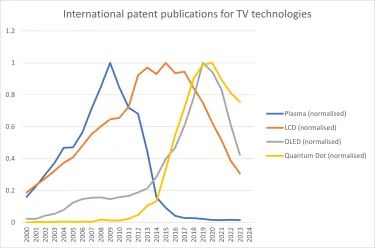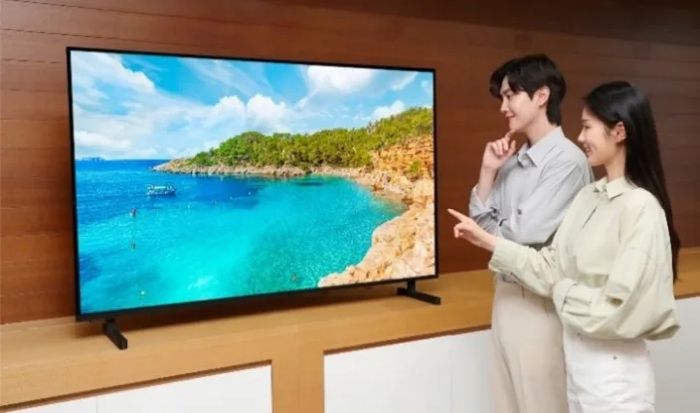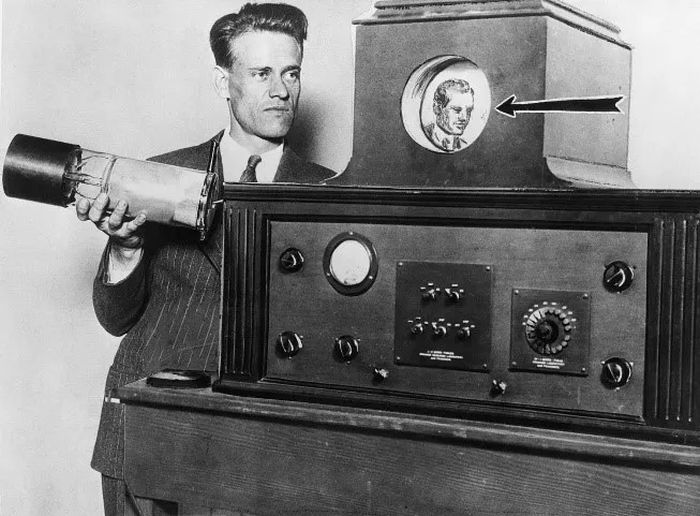It is very nearly 100 years since John Logie Baird's prototype "televisor" – later known as a mechanical television – was demonstrated in Selfridges department store in London in 1925 . Two years later, the first electronic television was patented by Philo Farnsworth (United States patent US 1,773,980).
These early electric televisions contained a cathode ray tube (CRT) in which a beam of electrons within the tube excite phosphor dots to generate a display. CRT TVs were bulky due to the size of the CRT, and the desirability of TVs with a slimmer profile spurred research including development of a flat cathode tube (patent US 2,795,731 filed in 1953) and research into plasma displays at the University of Illinois (patent US 3,559,190 filed in 1966) in which light is generated from a plasma.
A further display technology conceived in the 1960s at RCA Laboratories was LCD displays driven by a thin-film transistor (TFT) backplane, also known as active matrix LCD displays. LCD displays contain a liquid crystal layer in front of a backlight and, in the case of a colour display, a colour filter layer. Individual cells of the liquid crystal layer can be controlled by application of an electrical current to control the amount of light from the backlight that passes through the liquid crystal layer. LCD displays began appearing in watches and calculators in the 1970s.
Despite this research into thinner display technologies, bulky CRT TVs remained the dominant TV technology until plasma and LCD television technology had advanced sufficiently to replace CRTs from around 2000 onwards.
More recently, organic light-emitting diode (OLED) televisions have been commercialised. OLEDs emit light by application of electricity to a light-emitting layer containing organic electroluminescent materials between two electrodes. The light-emitting layer contains red, green and blue light-emitting electroluminescent materials, thus providing the colour gamut required for a full colour television without the need for a backlight. Early organic electroluminescent material research in the late 1980s and early 1990s included research at Kodak and the University of Cambridge.
Quantum dot (QD) technology has also been incorporated into modern LCD and OLED TVs. The colour of light emitted by a QD depends on its size, and the Nobel Prize for Chemistry was awarded in 2023 "for the discovery and synthesis of quantum dots".
The evolution of different display technologies can be tracked with patent filings as shown in Figure 1

Figure 1: International patent applications having the relevant display technology and the word "display" in the title or abstract. Results are normalised for each technology.
As shown in Figure 1, the number of patent filings for plasma display technology peaked several years before that for LCD display technology, and likewise LCD display technology patent filings peaked before those of OLED and QD technology, which tallies with the history in development of these technologies.
The near-total collapse of filings on plasma displays in recent years indicates that this display technology is now obsolete. For LCDs, however, although filings for LCD displays have passed a peak the ongoing number of filings in recent years is indicative of a market sustaining ongoing research and development for this technology; indeed, LCDs continue to be developed for TVs and other display applications.
Modern TVs contain a wide range of innovative technologies – for example, an OLED TV contains organic electroluminescent compounds having the requisite colour and lifetime; a device architecture designed to maximise electroluminescent efficiency; optics to maximise light output; electronics in the display backplane and drivers for addressing the display; and, in the case of smart TVs, an operating system for running apps installed on the TV. Each of these innovations in a commercially available TV will typically be protected by one or more patents either owned by or licensed to the TV manufacturer.
Conclusion
As well as demonstrating his invention in Selfridges, John Logie Baird approached the Express newspaper for publicity but the news editor reportedly gave this instruction: "For God's sake go down to reception and get rid of the lunatic who's down there. He says he's got a machine for seeing by wireless. Watch him – he may have a razor on him." This incredulity is reflected in the "stunned" reaction of Farnsworth's wife to his first demonstration of an electric television.
One can only imagine how they would have reacted to seeing a modern, large area flatscreen television; Arthur C Clarke's adage that any sufficiently advanced technology is indistinguishable from magic seems apposite here.

Marketing material for a QD-OLED TV

Philo Farnsworth with an early electrical television
The road from Farnsworth's first electrical television with a screen "about the size of a postage stamp" to a modern QD-OLED TV is marked by numerous patented inventions – many of them originating in university laboratories – which serve to protect the manufacturer's position in a highly competitive marketplace that has seen rapid advances in technology over the last two decades and that show no sign of slowing down.
The content of this article is intended to provide a general guide to the subject matter. Specialist advice should be sought about your specific circumstances.
